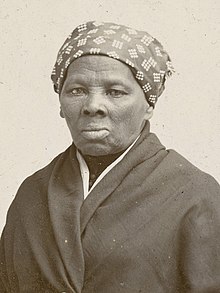
Back هاريت توبمان Arabic هاريت توبمان ARZ Harriet Tubman AST Harriet Tubman Aymara Harriet Tabmen Azerbaijani Harriet Tubman BCL Гарыет Табмен Byelorussian Хариет Тъбман Bulgarian Harriet Tubman BS Harriet Tubman Catalan
Harriet Tubman | |
|---|---|
 Tubman in 1895 | |
| Born | Araminta Ross c. March 1822[1] |
| Died | March 10, 1913 (aged 90–91) Auburn, New York, U.S. |
| Resting place | Fort Hill Cemetery, Auburn, New York, U.S. 42°55′29″N 76°34′30″W / 42.9246°N 76.5750°W |
| Other names |
|
| Occupations | |
| Known for | Guiding enslaved people to freedom |
| Spouses | |
| Relatives | See Harriet Tubman's family |
| Military career | |
| Allegiance | United States |
| Affiliation | U.S. Department of War |
| Rank | Brigadier General (posthumous) of the Maryland National Guard |
| Battles / wars | |
Harriet Tubman (born Araminta Ross, c. March 1822[1] – March 10, 1913) was an American abolitionist and social activist.[2][3] After escaping slavery, Tubman made some 13 missions to rescue approximately 70 enslaved people, including her family and friends,[4] using the network of antislavery activists and safe houses known collectively as the Underground Railroad. During the American Civil War, she served as an armed scout and spy for the Union Army. In her later years, Tubman was an activist in the movement for women's suffrage.
Born into slavery in Dorchester County, Maryland, Tubman was beaten and whipped by enslavers as a child. Early in life, she suffered a traumatic head wound when an irate overseer threw a heavy metal weight, intending to hit another slave, but hit her instead. The injury caused dizziness, pain, and spells of hypersomnia, which occurred throughout her life. After her injury, Tubman began experiencing strange visions and vivid dreams, which she ascribed to premonitions from God. These experiences, combined with her Methodist upbringing, led her to become devoutly religious.
In 1849, Tubman escaped to Philadelphia, only to return to Maryland to rescue her family soon after. Slowly, one group at a time, she brought relatives with her out of the state, and eventually guided dozens of other enslaved people to freedom. Tubman (or "Moses", as she was called) travelled by night and in extreme secrecy, and later said she "never lost a passenger".[5] After the Fugitive Slave Act of 1850 was passed, she helped guide escapees farther north into British North America (Canada), and helped newly freed people find work. Tubman met John Brown in 1858, and helped him plan and recruit supporters for his 1859 raid on Harpers Ferry.
When the Civil War began, Tubman worked for the Union Army, first as a cook and nurse, and then as an armed scout and spy. For her guidance of the raid at Combahee Ferry, which liberated more than 700 enslaved people, she is widely credited as the first woman to lead an armed military operation in the United States. After the war, she retired to the family home on property she had purchased in 1859 in Auburn, New York, where she cared for her aging parents. She was active in the women's suffrage movement until illness overtook her and was admitted to a home for elderly African Americans, which she had helped establish years earlier. Tubman is commonly viewed as an icon of courage and freedom.
- ^ a b Larson 2004, p. 16.
- ^ Armstrong 2022, p. 56.
- ^ Humez 2003, p. 156.
- ^ Larson 2004, p. xvii.
- ^ Clinton 2004, p. 192.